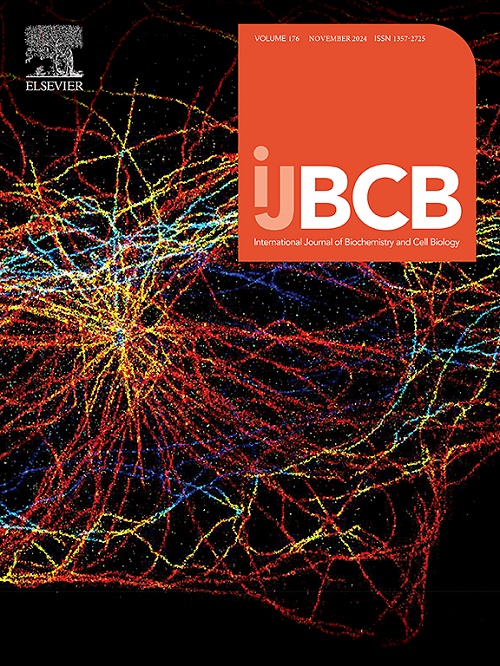Medium-dose irradiation impairs long-term hematopoietic stem cell functionality and hematopoietic resilience to cytotoxic stress
IF 2.8
3区 生物学
Q2 BIOCHEMISTRY & MOLECULAR BIOLOGY
International Journal of Biochemistry & Cell Biology
Pub Date : 2025-06-03
DOI:10.1016/j.biocel.2025.106814
引用次数: 0
Abstract
Irradiation and 5-fluorouracil (5-FU) are widely utilized tools in hematopoietic research to generate myeloablation and assess blood recovery dynamics. A comprehensive understanding of their effects on the hematopoietic system is essential for optimizing therapeutic strategies, refining experimental models to modulate hematotoxicity, and interpreting research outcomes. Despite their widespread application, the long-term hematopoietic impacts of irradiation and 5-FU, particularly on hematopoietic stem cells (HSCs), remain incompletely characterized. In this study, we therefore examined the long-term effects of 2 Gy medium-dose ionizing radiation (MDIR) and 150 mg/kg 5-FU on HSCs and the hematopoietic system’s resilience to subsequent cytotoxic stress in mice. Our findings demonstrate that MDIR, but not 5-FU, induces sustained impairments in HSC function and results in the selective depletion of MHC class II- HSCs – a subset characterized by high self-renewal potential and hypersensitivity to irradiation-induced ROS production. Furthermore, MDIR significantly compromised hematopoietic recovery following a subsequent 5-FU challenge, as evidenced by substantially reduced platelet and red blood cell (RBC) counts during the critical recovery phase. These findings highlight the distinct and persistent impacts of MDIR and 5-FU on HSCs and hematopoietic function, revealing crucial differences in their mechanisms of action and long-term consequences on the hematopoietic system.
中剂量照射损害造血干细胞的长期功能和造血对细胞毒性应激的恢复能力
照射和5-氟尿嘧啶(5-FU)是造血研究中广泛使用的工具,用于产生骨髓消融和评估血液恢复动力学。全面了解它们对造血系统的影响对于优化治疗策略、完善实验模型以调节血液毒性和解释研究结果至关重要。尽管其广泛应用,但辐射和5-FU的长期造血影响,特别是对造血干细胞(hsc)的影响仍未完全表征。因此,在本研究中,我们研究了2 Gy中剂量电离辐射(MDIR)和150 mg/kg 5-FU对小鼠造血干细胞和造血系统对随后细胞毒性应激的恢复能力的长期影响。我们的研究结果表明,MDIR,而不是5-FU,诱导HSC功能的持续损伤,并导致MHC II类- HSC的选择性消耗,MHC II类- HSC是一种具有高自我更新潜力和对辐射诱导的ROS产生超敏感的亚群。此外,MDIR显著损害了5-FU刺激后的造血恢复,在关键恢复阶段血小板和红细胞(RBC)计数显著减少。这些发现强调了MDIR和5-FU对造血干细胞和造血功能的独特而持久的影响,揭示了它们在作用机制和对造血系统的长期影响方面的关键差异。
本文章由计算机程序翻译,如有差异,请以英文原文为准。
求助全文
约1分钟内获得全文
求助全文
来源期刊
CiteScore
8.10
自引率
0.00%
发文量
124
审稿时长
19 days
期刊介绍:
IJBCB publishes original research articles, invited reviews and in-focus articles in all areas of cell and molecular biology and biomedical research.
Topics of interest include, but are not limited to:
-Mechanistic studies of cells, cell organelles, sub-cellular molecular pathways and metabolism
-Novel insights into disease pathogenesis
-Nanotechnology with implication to biological and medical processes
-Genomics and bioinformatics

 求助内容:
求助内容: 应助结果提醒方式:
应助结果提醒方式:


